Most of you are aware that Shimano completely overhauled their Dura Ace Di2 group. We covered our initial impressions of the official media launch HERE.
Before we begin, I’d like to offer a quick explanation of the Shimano numbering system. All of their products receive a number – which you often see – but can be easy to forget.
6700 – Mechanical 10-speed Ultegra
6770 – Electronic 10-speed Ultegra Di2
7900 – Mechanical 10-speed Dura Ace
7970 – Electronic 10-speed Dura Ace Di2
9000 – Mechanical 11-speed Dura Ace
9070 – Electronic 11-speed Dura Ace Di2
In this article, we will cover some of the key features of the new 9070 Dura Ace Di2.

E-Tube
The most important thing with new Di2 is the customization that is available. Now your mechanic will need not only wrenches to fix your bike – but also a computer.

Shimano calls their software “E-Tube”.

The whole idea behind E-Tube is that you can update, upgrade, and change the functionality of your components. Similar to many of the power meters and GPS devices we’re familiar with, not only do you need to keep the firmware of the component up-to-date, but the software on your computer will need updating as well. The most recent E-Tube version had the following updates:
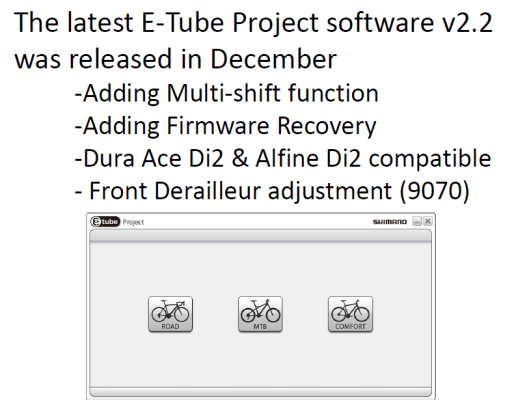
There are a couple ways to plug your bike in to your computer, each with some unique features. Upon initial release, Shimano offered the SM-PCE1. This is effectively the consumer-level diagnostic device. It allows you to update component firmware, change functions, and do basic diagnostics.

The newer and heavier-duty option is the SM-BCR2. The cool feature with this is that it allows you to charge the new internal battery option without removing it from the bike (rejoice, aero-electronics weenies). All you do is plug in to the junction box and connect it to your computer with the USB cable, or a USB wall adapter (i.e. from an iPhone). Note that you cannot charge the external battery in this manner; you must use the existing wall charger for that.
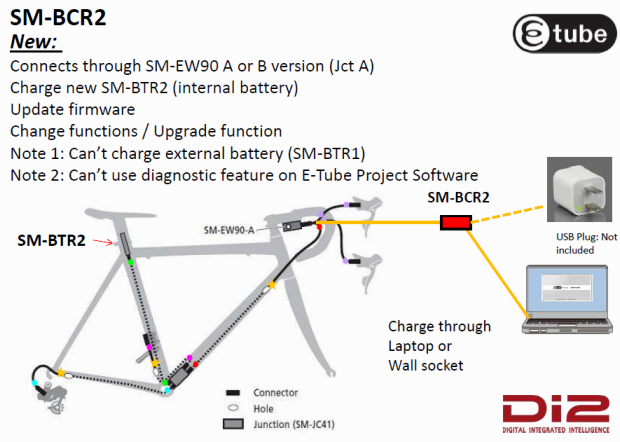
To give you an idea of how E-Tube works, we’ll walk through one function – setting up Multi-shift.
Multi-shift is a function that is new for 9070. Simply put, when you hold down a shift button, it will continue to shift the rear derailleur (rather than pushing the button five times for five shifts). The speed and number of shifts is completely programmable, which is what we will show you.
To start, you click on ‘Connection Check’:

Next, you must select the components that you have on your bike – the number of shifters, derailleurs, and auxiliary switches:

After clicking ‘Next’, E-Tube will attempt to confirm your selections. During this process, they say you must not unplug the system:

Next, it will confirm or question the selections you made. If you forgot to select which shifters you have, it will run a diagnostic, attempt to recognize what you have, and ask if it made the correct choice.

To begin setting up Multi-shift, click on ‘Customize’:

Then, click ‘Multi shift mode settings’:
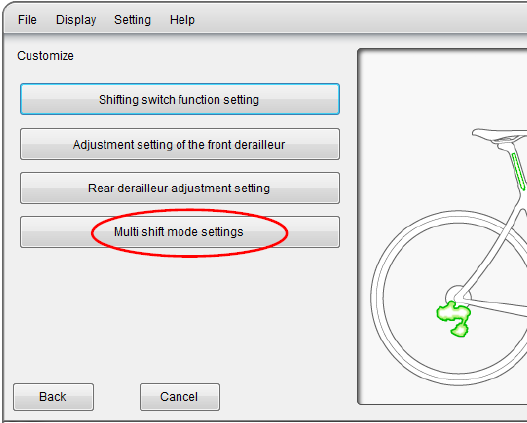
If Multi-shift is not already turned on, you can do so with the button at the top of the next screen. Below that, you see the options for customizing what you want. There are five settings for speed (how fast it cycles through the gears). You can also set the number of times it will shift – 2, 3, or unlimited. I test rode the system in ‘medium’ speed and unlimited gear changes. If I had to do it over again, I’d likely bump the speed up one notch (to ‘fast’), and keep it at unlimited.

Once you’ve made your selections, click ‘Set’, and then ‘Complete Setup’ on the following screen:
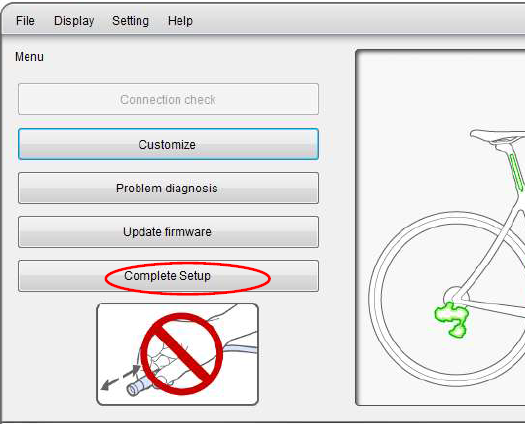
The cool part is that the door is open for future changes. If Shimano hears feedback that they need to add a different shift speed option, for example, they can add it.
E-Tube is the platform that you use to make all changes. You can decide which shift button does what. If you want your right hand to activate the front derailleur and your left to activate the rear, you can do so. If you want to reverse which button shifts up and down, that’s fine too. To get a better picture of your options, Shimano provided this graphic:

The key to new Di2 is the 5 port junction box. As you can see, there is also a 3 port junction, which comes stock on Ultegra 6770. We imagine that whether a bike comes stock with the 3 or 5-port is up to the bike manufacturer (but we can’t find a reason that you’d want the 3-port).
Each shifter takes up a slot in the junction box. If you want to run drop bar shifters PLUS bar-end shifters (i.e. on an ITU bike), that takes up four of the slots, leaving one for the charging/diagnostic devices to plug in to. Each drop bar shifter has three ports of their own, to accommodate both the sprint shifter and climbing shifter options. If you want to run ALL of the shifters on one bike, you can do so.
Shimano tells us that they are getting a lot of questions regarding cross-compatibility of systems (we certainly had some questions of our own). They provided this information to answer some of the more common concerns:
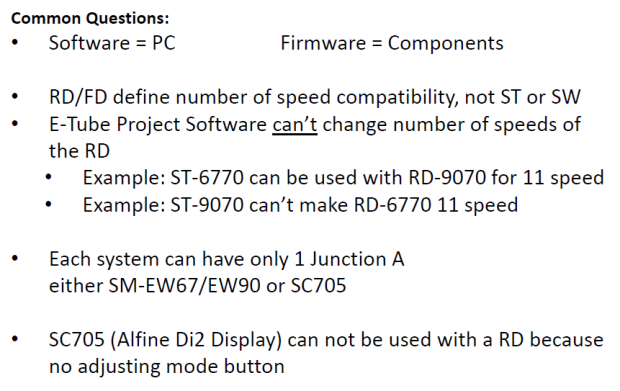
As you can see, it is the front and rear derailleurs that dictate to the system how many speeds it has. If you have a bike with Ultegra 6770 Di2 and want to change it to 11-speed, you would need to change to Dura Ace 9070 parts for the front derailleur, rear derailleur, crankset, cassette, chain and wheels (retaining only the Ultegra shifters and brakes). You cannot just add Dura Ace 9070 shifters to that bike and ‘force’ the Ultegra derailleurs to become 11-speed.
Here are a few more:

Having sifted through all of this information and attending the Shimano press event, I think the most important upgrade for Ultegra 6770 Di2 owners is to add the new 9070 brake levers and a 5-port junction box. As it stands, Ultegra 6770 ONLY has bar-end shifters. There are no auxiliary shift buttons on the brake levers. That – in my mind – is the key feature that triathletes want on their bikes; whether or not the rear cassette is 10 or 11 speeds is of secondary importance. If you have an existing bike with Ultegra 6770, all you need are the 5-port junction and brake levers, and you have the least expensive entry to dual-position electronic shifting.
Weight and Price
While I don’t normally talk a lot about weight and price very much, I think they are a notable part of this discussion. Shimano provided the following spreadsheet that details the weight reduction of new 9070 Dura Ace Di2:
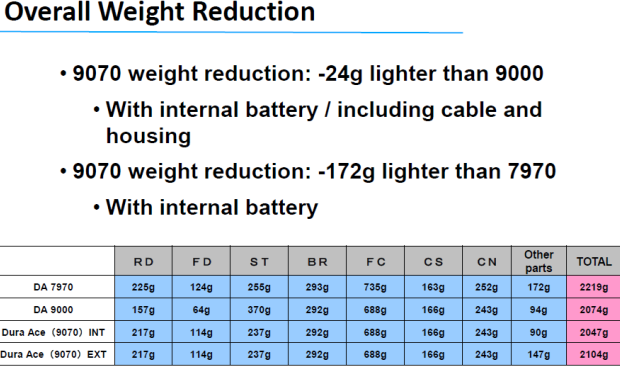
The elephant in the room? With the internal battery option, electronic shifting is now lighter than mechanical, at least in Shimano’s line. They’re also knocking on the door of the 2,000 gram barrier for the complete groupset. Only a few years ago, that was a pipe dream.
Where has price gone?

The saying goes, “You get what you pay for.”
I’m not one to beat the price point to death. We all form our own opinions on what qualifies as expensive or not. What I will say is that – I think – Shimano is delivering a lot of value. The price is high, but the stuff works really, really well. If it did not work well, I would have much more issue with the price. It will be out of reach for some (perhaps many). That being the case, I think the upgraded 6770 (with 5 port junction and auxiliary brake lever shifters) is a fantastic option that offers 90% of the function, at 60% of the price. Of course, there are still many more lower-priced mechanical options, such as 105 and Tiagra.
What do you think? Is new Di2 what you hoped for and expected? Is it the best-thing-ever? Is it too complicated, and we should all go back to 7-speed downtube shifters?
--
All images courtesy of Shimano




